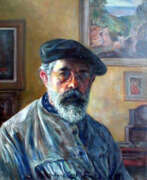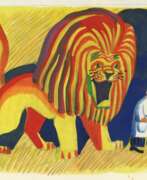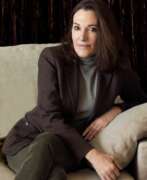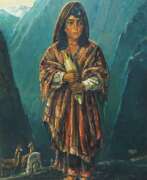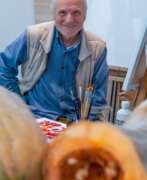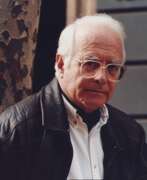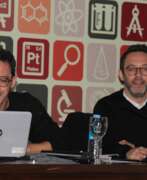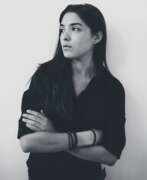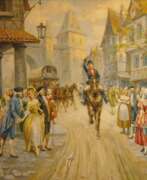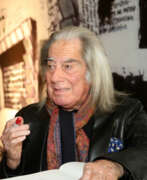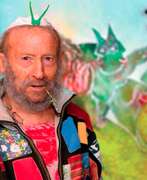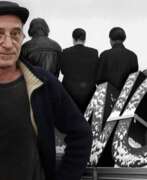Spain Contemporary art


Nuria Farre Abejon is a Spanish hyperrealist artist living and working in Barcelona, Spain.
Her often hyper-realistic works revolve around issues that concern her as a young woman: anxiety, melancholy, family, memories and identity. At first, Nuria created translucent paintings through which she represented the duality between life and death. Later she explored self-portraiture, and today Nuria tries to explore her present through photographs from her family album, through which she creates interesting visual oil collages.


Frederico Aguilar Alcuaz is a Filipino abstract painter, sculptor and ceramist, and master tapestry artist.
He studied painting at the University of the Philippines' School of Fine Arts, then lived and worked both in the Philippines and Spain, and in Brno, Czech Republic, he worked extensively on tapestries.
Alcuaz has earned international acclaim with his vivid abstract works in various genres and techniques, and he has exhibited extensively internationally.


Andreu Alfaro Hernández was a Spanish sculptor.
Alfaro learned the principles of geometry and applied his knowledge to create abstract works. His sculptures are usually full of nuances that play with the module, the series and light and color. He was also described as a minimalist artist, albeit with reservations.


Erwin Bechtold is a German abstract painter and sculptor. He spent some time in Paris, where he had the opportunity to work with Fernand Léger.
Erwin Bechtold was the founder of the artist's group Ibiza 59, whose members sought to create art free of subjective expression. Bechtold's paintings from this period were characterised by minimal geometric forms and the use of a monochromatic colour palette.
Later in his career, Bechtold began experimenting with sculpture, creating large-scale works that explored the relationship between form and space.


Miguel Ortiz Berrocal was a Spanish figurative and abstract sculptor. He is best known for his puzzle sculptures, which can be disassembled into many abstract pieces. These works are also known for the miniature artworks and jewelry incorporated into or concealed within them, and the fact that some of the sculptures can be reassembled or reconfigured into different arrangements. Berrocal's sculptures span a wide range of physical sizes from monumental outdoor public works, to intricate puzzle sculptures small enough to be worn as pendants, bracelets, or other body ornamentation.


Miguel Rio Branco, full name Miguel da Silva Paranhos do Rio Branco, is a Brazilian photographer, artist, director and creator of multimedia installations.
His father was a diplomat and as a child Miguel lived in Spain, Portugal, Switzerland and the USA, now living and working in Rio de Janeiro, Brazil. After earning a degree in photography from the New York Institute of Photography, Miguel first worked as a cameraman and then worked with the Magnum agency. Miguel is known for exploring and crossing two different art forms: painting and photography. He has also shot 14 short films and eight long films, he is recognized in the world as one of the best color photojournalists.
Miguel Rio Branco's photographs are part of the collections of the Museum of Modern Art and the Metropolitan Museum of Art in New York.


Fran Bull is an American sculptor, painter, and print-maker living and working in Brandon, Vermont and Barcelona, Spain. Bull became known originally for her Photorealism paintings made in the mid 1970s and 80s. In the late 1980s, Bull’s art began to develop towards abstraction, or neo-abstract expressionism. Sparked by her newfound approach to painting, in the mid-1990s Bull began to explore other media. Since that time her artistic output has included performance art, sculpture, mixed media, and printmaking, as well as painting. She has been especially prolific in the area of printmaking. Bull has produced many diverse series of etchings that continue to be exhibited worldwide.


Carmen Calvo, full name Carmen Calvo Sáenz de Tejada, is a Spanish conceptual artist and sculptor.
Carmen Calvo is one of the most representative Spanish conceptual artists of our time. She studied at the School of Arts and Crafts and then at the School of Fine Arts of Valencia, worked in a ceramic factory and since then always incorporates fired clay in her plastic compositions. The artist also works in scenography using photography and other, very diverse formal, technical and thematic resources.
In 2013, Carmen Calvo was awarded the National Award for Plastic Arts by the Ministry of Education, Culture and Sport, and in 2014 she was appointed Academician of the Royal Academy of Fine Arts of San Carlos de Valencia.


Alfredo Castañeda was a Mexican surrealist painter.
Castañeda had been interested in painting and drawing since childhood, but first became an architect, earning a degree in architecture from the University of Mexico. During his studies, he continued to paint as a hobby, which he became more and more serious about over the years. At university, Alfredo became acquainted with the painter, sculptor and architect Matthias Goeritz, as well as the work of René Magritte. Both played a huge role in the young artist's worldview.
After his studies, Castañeda worked as an architect and in 1969 had his first solo exhibition at Galeria de Arte Mexicano. His work has also been shown internationally numerous times in the United States and in many Latin American countries, including Mexico. His work is collected in collections and museums throughout the Americas, Europe and Asia.
Alfredo Castañeda is known for his surrealist paintings, often portraits. The same character appears in many of his paintings, sometimes revealed in multiple versions of himself. This person (often resembling the artist himself) seems to be engaged in an endless dialog with himself, involving the viewer as well.


Antoni Clavé was a Catalan master painter, printmaker, sculptor, stage designer and costume designer. He was nominated for two Academy Awards (Best Art Direction and Best Costume Design) for his work on the 1952 film Hans Christian Andersen.
Clavé was one of Spain's best known and most celebrated artists. His work evolved from a baroque, ornamental style to a pure, minimal aesthetic. In his later years, his work is completely abstract, employing expressive lines and exploring the boundaries of collage, objet trove, shading, texture and color. He was trained at the School of Fine Arts, Barcelona, where he was taught by Angel Ferrant and Felix Mestres. With his works being influenced by artists such as Bonnard, Vuillard and Roualt. He is best known for his lyrical abstractions, works which combine paint with collage.


Albrecht Demitz is a German graphic artist and sculptor who belongs to the "New Fauves" (German "Neue Wilde") group in Berlin. His paintings are often expressive, abstract and executed in expressive bright colors. He works in silkscreen techniques in particular, and creates sculptures from various materials - wood, twigs, stones, metals and waste.


Jesús Mari Lazkano is a Spanish Basque painter. He graduated in fine arts from the University of the Basque Country, where he is Professor of Fine Arts, and has had exhibitions in Europe, America and Asia. Some of his work is part of the Bilbao Guggenheim Museum collection.
Along with Jose Venero, he made the movie Artiko, which was selected to appear at the In The Palace International Short Film Festival in Varna, Bulgaria, and the Ulju Mountain Film Festival, South Korea.


Ximo Lizana is a Spanish media artist, multidisciplinary creator of the world of new media art and technological art, living and working in Madrid.
Ximo Lizana was the first artist in the history of Spanish art to include robotics in the collections of contemporary art (IVAM). He is a professor at UEM and winner of the National Prize in New Media Art and Technological Art.


Horst G. Loewel is a German-born painter who lives and works in Canada and Spain.
Loewel is a representative of the fantastical-surrealistic trend in art. He meticulously and realistically depicts landscapes of another universe filled with symbolism. Thanks to his boundless imagination, the artist shows us a fabulous, unreal world in which man has almost no place.


Los Carpinteros is a Cuban artist collective founded in Havana in 1992 by Marco Antonio Castillo Valdes, Dagoberto Rodriguez Sanchez, and Alexandre Arrechea (who left the group in 2003).
In their work the artists incorporate aspects of architecture, design and sculpture to create installations and drawings that “negotiate the space between the functional and the nonfunctional", where they derive their “inspiration from the physical world” and express their interest in the intersection of art and society in a humorous manner. Los Carpinteros create a response to places, spaces and objects, how they have been conceived, built, used and abandoned.


Carlos García Muela is a Spanish sculptor.
Carlos Muela studied at the National School of Fine Arts in Tetouan, Spanish protectorate of Morocco, he moved to Madrid in 1974.
His first sculptures were made of sandstone and were rather crude. Later he began to create more expressionist works in iron or bronze. In 1970, Muela began his series of Torsos of classical character, which became the basis of his work. The sculptor achieved highly expressive figures by breaking and layering them. This was achieved by spreading layers of wax, which broke at the moment of casting in bronze, thus enhancing the effect of the passage of time on the sculptural object.


Eva Navarro is a Spanish painter living in Madrid, Spain. She has a bachelor's degree in Fine Arts from the Universidad Complutense de Madrid. Her work is considered part of the Spanish New Figurative Art Movement. She mostly exhibits her work in Europe and the United States.
Navarro's work has been described as "vivacious, uncomplicated and energetic, as well as being full of extraordinary colour". Basic elements such as movement, space, action and time, all expressed through the human figure, are reflected in her work.


Felipe Orlando, full name Juan de Dios Felipe Orlando García Murciano, was a Spanish-Cuban artist who lived in Spain and devoted himself to writing for a living through painting. He was an anthropologist by training and a musicologist by hobby.
Belonging to the artistic avant-garde movement that emerged in the 1930s, it is difficult to place his painting in the mainstream of young modernists.
Felipe Orlando's painting is characterised by a constant development. It begins with paintings that could be called figurative. They are usually always interior scenes in which women, Afro-Cubans or still lifes take centre stage.
After moving to Spain, his painting develops towards abstraction, especially the informal current, but always presents some figurative reference. Serenity and lyricism prevail in the textures. The titles are suggestive and colour is more important than form.


Rinaldo Paluzzi was an American-Spanish Abstract Art and Geometric abstraction painter and sculptor in the post-World War II era.
Paluzzi’s works are in a number of permanent collections, from the Hirshhorn Museum and Sculpture Garden at the Smithsonian to the Union Fenosa Museum of Contemporary Art in Coruna, Spain.


Jaume Plensa i Suñé is a Spanish visual artist, sculptor, designer and engraver. He is a versatile artist who has also created opera sets, video projections and acoustic installations. He worked with renowned Catalan theatrical group La Fura dels Baus. He is better known for his large sculptures made up of letters and numbers.


Salustiano is a Spanish painter who lives and works in Seville.
Salustiano graduated from the University of Seville (Spain) and in the early 1990s was inspired by the works of the Renaissance masters. The artist depicts human beings in the classical Renaissance style, but hyper-realistically, on a monochrome background, focusing entirely on the personality and soul. Surrealism adds mystery and mystery, even ambiguity, to the models.
Salustiano's paintings are highly praised by connoisseurs of contemporary art. He has shown his paintings in exhibitions at the Fowler Museum in Los Angeles, the Luma Museum in Chicago, and the Fostella-Malpartida Museum in Caceres. Various prestigious charitable organizations have invited him to collaborate on their projects: The Dalai Lama Foundation with the exhibition "The World Missing", Women Together International with the exhibition "Otras Meninas" and the Cisneros Foundation.


Deva Sand is a French artist, sculptor and graphic designer. She currently lives and works in Valencia, Spain.
She has received an honorary award from Caja Madrid and Bancaja two years in a row. She participated in the first Valencia Biennale and has worked with Spanish gallerists Tomas March and Travezia Cuatro for several years. She now collaborates with Pilar Dolz of the Caném Gallery in Castellón.


Francisco Sobrino Ochoa was a Spanish sculptor. His career began in 1959 when he moved to Paris to have a start in his career. His works can be seen in Tel Aviv, Guadalajara, Chicago, Madrid, New York City and Paris. Sobrino was born in Guadalajara, Spain and lived in Paris.


Ramon Surinyac is a Spanish painter living and working in Barcelona, Spain.
Ramon Surinyac holds a Bachelor of Fine Arts from the University of Barcelona. From a distance, his paintings look like large photographs of snow-capped mountain vistas, ocean waves or forest jungles, but when the viewer gets closer, he discovers the artist's amazingly realistic skill.


Juan Uslé Oceja is a Spanish contemporary painter. His work varies between abstraction and figurative representation. In 2002, he received the Premio Nacional de Artes Plásticas, a national arts prize awarded by the Ministerio de Cultura of Spain. He works both in New York City and in Saro in Cantabria.


Manolo Valdés is a Spanish painter and sculptor who co-founded the influential Spanish pop art movement Equipo Cronica in 1964 with Rafael Solbes and Juan Antonio Toledo during the Franco dictatorship. Manolo Valdés uses art as a channel of expression. With humour and irony he depicts the political and social obligations of the state.
His large-scale paintings, sculptures and combined works are an open dialogue with reference to the masters of art history.




































